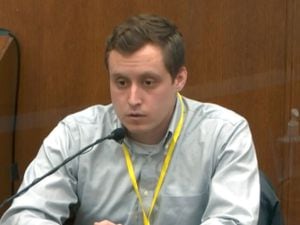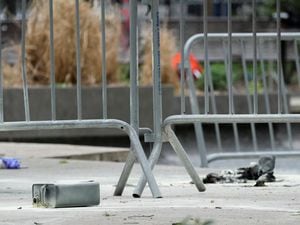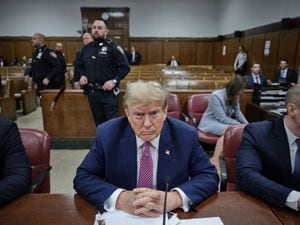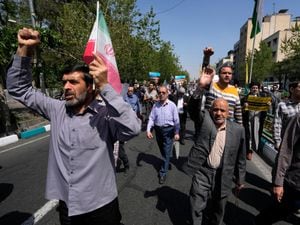Doctor testifies he theorised that lack of oxygen stopped George Floyd’s heart
Dr Bradford Langenfeld took the stand at the beginning of the second week of former Minneapolis Officer Derek Chauvin’s trial.

The emergency room doctor who pronounced George Floyd dead after trying to resuscitate him testified on Monday that he theorised at the time that Mr Floyd’s heart most likely stopped because he did not get enough oxygen.
Dr Bradford Langenfeld, who was a senior resident on duty that night at Hennepin County Medical Centre, took the stand at the beginning of the second week of former Minneapolis Officer Derek Chauvin’s murder trial, as prosecutors sought to establish that it was Chauvin’s knee on the black man’s neck that killed him.
Dr Langenfeld said Mr Floyd’s heart had stopped by the time he arrived at the hospital.
The doctor said that he was not told of any efforts at the scene by bystanders or police to resuscitate Mr Floyd but that paramedics told him they had tried for about 30 minutes.

Under questioning by prosecutor Jerry Blackwell, Dr Langenfeld said that based on the information he had, it was “more likely than the other possibilities” that Mr Floyd’s cardiac arrest — the stopping of his heart — was caused by asphyxia, or insufficient oxygen.
Chauvin, 45, is charged with murder and manslaughter in Mr Floyd’s death on May 25.
The white officer is accused of pinning his knee on the 46-year-old man’s neck for nine minutes, 29 seconds, as Mr Floyd lay face-down in handcuffs outside a corner market, where had been accused of trying to pass a counterfeit 20-dollar note for a pack of cigarettes.
The defence argues that Chauvin did what he was trained to do and that Mr Floyd’s use of illegal drugs and his underlying health conditions caused his death.
Chauvin lawyer Eric Nelson questioned Dr Langenfeld about whether some drugs can cause hypoxia, or insufficient oxygen. The doctor acknowledged that fentanyl and methamphetamine, both of which were found in Mr Floyd’s body, can do so.
The county medical examiner’s office ultimately classified Mr Floyd’s death a homicide — that is, a death at the hands of someone else.
The full report said Mr Floyd died of “cardiopulmonary arrest, complicating law enforcement subdual, restraint, and neck compression”.
A summary report listed fentanyl intoxication and recent methamphetamine use under “other significant conditions” but not under “cause of death”.
Under cross-examination from Mr Nelson, Dr Langenfeld said Mr Floyd’s carbon dioxide levels were more than twice as high as levels in a healthy person, and he agreed that that could be attributed to a respiratory problem. But on questioning from the prosecutor, the doctor said the high levels were also consistent with cardiac arrest.
Dr Langenfeld also testified that neither he nor paramedics administered a drug that would reverse the effects of an opioid overdose. The doctor said giving Narcan once a patient is in cardiac arrest would provide no benefit.
Dr Langenfeld said that “any amount of time” a patient spends in cardiac arrest without immediate CPR decreases the chance of a good outcome. He said there is an approximately 10% to 15% decrease in survival for every minute that CPR is not administered.

Prosecutors in the second week of the trial are also expected to zero in on Chauvin’s training in the use of force.
Minneapolis Police Chief Medaria Arradondo took the stand on Monday, testifying about police policy that dictates that whenever it is reasonable to do so, officers must use tactics to deescalate a situation so as to avoid or minimise the use of force.
Prosecutor Steve Schleicher noted that while some people may become more dangerous under the influence of drugs or alcohol, some may actually be “more vulnerable”.
Mr Arradondo agreed and acknowledged that this must also be taken into consideration when officers decide to use force.
“It’s recognising that when we get the call from our communities, it may not often be their best day, and they may be experiencing something that’s very traumatic,” the chief said.
Mr Arradondo, the city’s first black chief, fired Chauvin and three other officers the day after Mr Floyd’s death.
The city moved soon after Mr Floyd’s death to ban police chokeholds and neck restraints. Mr Arradondo and Mayor Jacob Frey also made several policy changes, including expanding requirements for reporting use-of-force incidents and documenting attempts to de-escalate situations.





